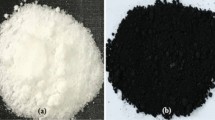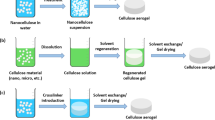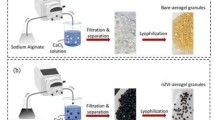Abstract
In this study, hydrophobic silica aerogels were synthesized from rice husk ash-derived sodium silicate through sol-gel processing, solvent exchange, surface modification and ambient pressure drying. By volume, 10% of trimethylchlorosilane (TMCS) in 90% of n-hexane was used as a hydrophobic solution in the surface modification process. The physical and chemical properties of silica aerogels were characterized by density and porosity measurements, scanning electron microscopy (SEM), Fourier transforms infrared (FTIR) spectroscopy, Brunauer–Emmett–Teller theory (BET) and dynamic scanning calorimetry (DSC). The hydrogels prepared were in the form of 2.5 ± 0.5 mm beads and then converted into alcogels through solvent exchange with ethanol for repetition of 3, 6 and 9 days. It is found that the optimal quality of silica aerogels with the BET surface area as high as 668.82 m2/g was obtained from the alcogels of the solvent exchange period of 9 days. Depending on the size of the gel’s block, a longer solvent exchange period will ensure adequate removal of pore water. Post heat treatment on silica aerogels obtained from the 9 days of solvent exchange at 200, 300 and 400 °C for 2 h results in slight decreased of aerogel’s density from 0.048 g/cm3 to 0.039 g/cm3 and the hydrophobicity of the aerogels is decreased above 380 °C as confirmed by DSC analysis.
Similar content being viewed by others
References
Maleki H, Durães L, Portugal A (2014) An overview on silica aerogels synthesis and different mechanical reinforcing strategies. J Non-Cryst Solids 385:55–74
Baetens R, Jelle BP, Gustavsen A (2011) Aerogel insulation for building applications: a state-of-the-art review. Energy and Buildings 43(4):761–769
Salimian S, Zadhoush A, Naeimirad M, Kotek R, Ramakrishna S (2018) A review on aerogel: 3D nanoporous structured fillers in polymer-based nanocomposites. Polym Compos 39(10):3383–3408
Halim ZAA, Yajid MAM, Idris MH, Hamdan H (2018) Dispersion of polymeric-coated–silica aerogel particles in unsaturated polyester composites: effects on thermal-mechanical properties. J Dispers Sci Technol 39(8):1093–1101
Nazriati N, Setyawan H, Affandi S, Yuwana M, Winardi S (2014) Using bagasse ash as a silica source when preparing silica aerogels via ambient pressure drying. J Non-Cryst Solids 400:6–11
Kow KW, Rozita Y, Aziz ARA, Abdullah EC (2014) From bamboo leaf to aerogel: preparation of water glass as a precursor. J Non-Cryst Solids 386:76–84
Liu SW, Wei Q, Cui SP (2016) Hydrophilic silica aerogel derived from wheat husk ash by ambient pressure drying. J Sol-Gel Sci Technol 78:60–67
Wu X, Fan M, Mclaughlin JF, Shen X, Tan G (2018) A novel low-cost method of silica aerogel fabrication using fly ash and trona ore with ambient pressure drying technique. Powder Technol 323:310–322
Zhu L, Wang Y, Cui S, Yang F, Nie Z, Li Q, Wei Q (2018) Preparation of silica aerogels by ambient pressure drying without causing equipment corrosion. Molecules 23(8):1935
Feng Q, Chen K, Ma D, Lin H, Liu Z, Qin S, Luo Y (2018) Synthesis of high specific surface area silica aerogel from rice husk ash via ambient pressure drying. Colloids Surf A Physicochem Eng Asp 539:399–406
Pan Y, He S, Cheng X, Li Z, Li C, Huang Y, Gong L (2017) A fast synthesis of silica aerogel powders-based on water glass via ambient drying. J Sol-Gel Sci Technol 82(2):594–601
Koebel MM, Huber L, Zhao S, Malfait WJ (2016) Breakthroughs in cost-effective, scalable production of superinsulating, ambient-dried silica aerogel and silica-biopolymer hybrid aerogels: from laboratory to pilot scale. J Sol-Gel Sci Technol 79(2):308–318
Wang J, Zhang Y, Wei Y, Zhang X (2015) Fast and one-pot synthesis of silica aerogels via a quasi-solvent-exchange-free ambient pressure drying process. Microporous Mesoporous Mater 218:192–198
Cui S, Yu S, Lin B, Shen X, Gu D (2015) Preparation of SiO2 aerogel from rice husk ash. RSC Adv 5(81):818–826
Hassan AF, Abdelghny AM, Elhadidy H, Youssef AM (2014) Synthesis and characterization of high surface area nanosilica from rice husk ash by surfactant-free sol–gel method. J Sol-Gel Sci Technol 69(3):465–472
Tadjarodi A, Haghverdi M, Mohammadi V (2012) Preparation and characterization of nano-porous silica aerogel from rice husk ash by drying at atmospheric pressure. Mater Res Bull 47(9):2584–2589
Bhattacharyya SC (2014) Viability of off-grid electricity supply using rice husk: a case study from South Asia. Biomass Bioenergy 68:44–54
Foletto EL, Gratieri E, de Oliveira LH, Jahn SL (2006) Conversion of rice hull ash into soluble sodium silicate. Mater Res 9(3):335–338
Pisal AA, Rao AV (2016) Comparative studies on the physical properties of TEOS, TMOS and Na2SiO3 based silica aerogels by ambient pressure drying method. J Porous Mater 23(6):1547–1556
Mahadik DB, Rao AV, Rao AP, Wagh PB, Ingale SV, Gupta SC (2011) Effect of concentration of trimethylchlorosilane (TMCS) and hexamethyldisilazane (HMDZ) silylating agents on surface free energy of silica aerogels. J Colloid Interface Sci 356(1):298–302
Rao AP, Rao AV (2009) Modifying the surface energy and hydrophobicity of the low-density silica aerogels through the use of combinations of surface-modification agents. J Mater Sci 45(1):51–63
Fei Shi LW (2007) Effect of heat treatment on silica aerogels prepared via ambient drying. J Mater Sci Technol 23(3):402–406
Wu G, Yu Y, Cheng X, Zhang Y (2011) Preparation and surface modification mechanism of silica aerogels via ambient pressure drying. Mater Chem Phys 129(1–2):308–314
Yun S, Luo H, Gao YF (2014) Superhydrophobic silica aerogel microspheres from methyltrimethoxysilane: rapid synthesis via ambient pressure drying and excellent absorption properties. RSC Adv 9:4535–4542
Sarawade PB, Kim JK, Hilonga A, Kim HT (2010) Production of low-density sodium silicate-based hydrophobic silica aerogel beads by a novel fast gelation process and ambient pressure drying process. Solid State Sci 12:911–918
Perdigoto MLN, Martins RC, Rocha N, Quina MJ, Gando-Ferreira L, Patrício R, Durães L (2012) Application of hydrophobic silica based aerogels and xerogels for removal of toxic organic compounds from aqueous solutions. J Colloid Interface Sci 380(1):134–140
Nadargi DY, Latthe SS, Rao AV (2009) Effect of post treatment (gel aging) on the properties of Methyltrimethoxysilane based silica aerogels prepared by two-step sol-gel process. J Sol-Gel Sci Technol 49(1):53–59
Iswar S, Malfait WJ, Balog SF, Winnefeld L, Lattuada M, Koebel MM (2017) Effect of aging on silica aerogel properties. Microporous Mesoporous Materials 241:293–302
Thommes M, Kaneko K, Neimark AV, Olivier JP, Rodriguez-Reinoso F, Rouquerol J, Sing KSW (2015) Physisorption of gases, with special reference to the evaluation of surface area and pore size distribution (IUPAC Technical Report). Pure Appl Chem 87(9–10):1051–1069
Al-Oweini R, El-Rassy H (2009) Synthesis and characterization by FTIR spectroscopy of silica aerogels prepared using several Si(OR)4 and R′′Si(OR′)3 precursors. J Mol Struct 919:140–145
Fidalgo A, Ilharco LM (2004) Correlation between physical properties and structure of silica xerogels. J Non-Cryst Solids 347(1–3):128–137
Rubio F, Rubio J, Oteo JL (1998) A FT-IR study of the hydrolysis of Tetraethylorthosilicate (TEOS). Spectroscopy Letters: An International Journal for Rapid Communication 31(1):199–219
Oikawa K, Toyota K, Sakatani S, Hayashi Y (2017) Effect of organic hydrophobic groups on the pore structure and thermal properties of waterglass-based silica xerogels. J Ceram Soc Jpn 125(12):906–912
Kondo T, Sawatari C (1996) A fourier transform infra-red spectroscopic analysis of the character of hydrogen bonds in amorphous cellulose. Polymer 37:393–399
Abadi MHS, Delbari A, Fakoor Z, Baedi J (2015) Effects of annealing temperature on infrared spectra of SiO2 extracted from Rice husk. Journal of Ceramic Science and Technology 6(1):41–46
Li Z, Cheng X, Gong L, Liu Q, Li S (2018) Enhanced flame retardancy of hydrophobic silica aerogels by using sodium silicate as precursor and phosphoric acid as catalyst. J Non-Cryst Solids 481:267–275
Yu H, Liang X, Wang J, Wang M, Yang S (2015) Preparation and characterization of hydrophobic silica aerogel sphere products by co-precursor method. Solid State Sci 48:155–162
Acknowledgments
The authors would like to thank the Research Management Centre (RMC) Universiti Teknologi Malaysia, the Ministry of Science, Technology, and Innovation (MOSTI) and the Ministry of Education of Malaysia for funding this project through research grants, 03-01-06-SF1456, FRGS 5F023 and HIR 04G38.
Author information
Authors and Affiliations
Corresponding author
Additional information
Publisher’s Note
Springer Nature remains neutral with regard to jurisdictional claims in published maps and institutional affiliations.
Rights and permissions
About this article
Cite this article
Halim, Z.A.A., Yajid, M.A.M. & Hamdan, H. Effects of Solvent Exchange Period and Heat Treatment on Physical and Chemical Properties of Rice Husk Derived Silica Aerogels. Silicon 13, 251–257 (2021). https://doi.org/10.1007/s12633-020-00421-5
Received:
Accepted:
Published:
Issue Date:
DOI: https://doi.org/10.1007/s12633-020-00421-5




